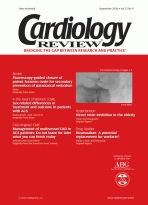Publication
Article
Cardiology Review® Online
Differences in treatment and outcomes in women with ACS
Author(s):
More than 1 million percutaneous coronary interventions (PCIs) are performed annually in the United States.
More than 1 million percutaneous coronary interventions (PCIs) are performed annually in the United States.1 Although more women than men die from cardiovascular disease in this country every year, and the benefits of PCI in reducing fatal and nonfatal ischemic complications in patients with acute myocardial infarction (MI) and high-risk acute coronary syndromes (ACS) are well-established, less than one-third of PCIs annually are performed in women.1-3 Significant sex-related disparities exist in time to intervention, referral to diagnostic catheterization, and use of evidence-based medicine.3-7 While some of these disparities have been explained by women’s older age at presentation, greater risk profile, and increased risk for an adverse procedural outcome; differences in symptoms and in pain perception between men and women, and a lower predictive accuracy of noninvasive testing in women; data from numerous studies suggest sex bias in treatment.4-7
The AMIS (Acute Myocardial Infarction in Switzerland) Plus prospective cohort study compared treatment and in-hospital outcomes between men and women with ACS admitted to Swiss hospitals between 1997 and 2007. This study provides a unique opportunity to explore sex differences in care and clinical outcomes in a large, nationally representative cohort of men and women. In total, 7341 women and 19,111 men (N = 26,452) were randomly selected for the analysis. Patients were included in the study if they met the following criteria: ST-segment elevation MI (STEMI), defined as ST-segment elevation or new left bundle branch block on initial electrocardiogram (ECG) and elevated cardiac enzymes (levels of total creatinine kinase [CK; normal, <2.8 μkat/L] or CK-MB fractions [normal, <5 μg/L]) at least twice the upper limits of normal; non—ST-segment elevation MI (NSTEMI), defined as symptoms and ECG changes, or both compatible with ACS and elevated cardiac enzymes not meeting the criteria for STEMI; and unstable angina pectoris, defined as symptoms and ECG changes, or both compatible with ACS and normal cardiac enzymes.
Not surprisingly, the mean age of the women in the study was 7 years greater than the mean age of the men. Women were more likely to have hypertension and diabetes, but less likely to have dyslipidemia, be overweight, or smoke compared with men. On average, women arrived later after symptom onset, with higher Killip class, and more dyspnea, ST-segment depression, left bundle branch block, or atrial fibrillation compared with men. With respect to treatment strategies, women were less likely to receive aspirin, clopidogrel, glycoprotein IIb/IIIa antagonists, beta blockers, and lipid-lowering drugs than men. Women were also less likely to undergo PCI than men. After robust adjustment, female sex remained an independent factor that decreased a patient’s likelihood of undergoing PCI (odds ratio [OR], 0.83; 95% confidence interval [CI], 0.78-0.89; P <.001). While crude in-hospital mortality was higher overall for women than for men (9.8% vs 5.9%, respectively; P <.001) irrespective of NSTEMI, after adjusting for covariates, sex was no longer an independent predictor of in-hospital mortality (adjusted OR for men vs women, 1.07; 95% CI, 0.94-1.22). Consistent with other studies, young women (aged 51 to 60 years) had statistically greater mortality than men of the same age.
The AMIS PLUS study confirms findings from other large studies that women tend to have higher risk ACS presentations than men, which results from delays in seeking treatment and older patient age at presentation. Furthermore, women are less likely to receive evidence-based therapies, including PCI, when presenting with ACS. However, once these significant differences are accounted for, mortality rates are similar between the sexes, except for young women presenting with ACS. This is consistent with clinical trial data from such studies as the TACTICS—TIMI (Treat Angina with Aggrastat and Determine Cost of Therapy with an Invasive or Conservative Strategy—Thrombolysis in Myocardial Infarction)–18 trial that found that employing an early invasive approach in ACS patients with non–ST-segment elevation benefitted both sexes, although this finding is contrary to the FRISC II (Fragmin and Fast Revascularization During Instability in Coronary Artery Disease II) and RITA 3 (Third Randomized Intervention Trial of Unstable Angina) trials, which found no benefit of an early invasive approach in women.
The AMIS PLUS study reached several important conclusions that provide further insight into the management of ACS in women. It is well-described that women have different baseline characteristics compared with men at admission, are less likely to be treated with evidence-based therapies, and are significantly less likely to undergo PCI. After adjusting for these differences, there were no significant differences in the rates of in-hospital mortality between men and women, overall. These results provide important impetus for strategies to increase awareness in women and physicians alike regarding the signs and symptoms of ACS in order to promote earlier presentation and diagnosis, consistent application of evidence-based approaches irrespective of sex, and rapid referral of both men and women for PCI. The 1 exception is that younger women remain at higher risk of mortality when presenting with MI. The AMIS PLUS study is not unique in this regard. Ongoing studies, such as the VIRGO (Variation In Recovery: Role of Gender on Outcomes of Young AMI Patients; http://www.virgostudy.com) study may shed light on sex-disparities in young women with ACS.






